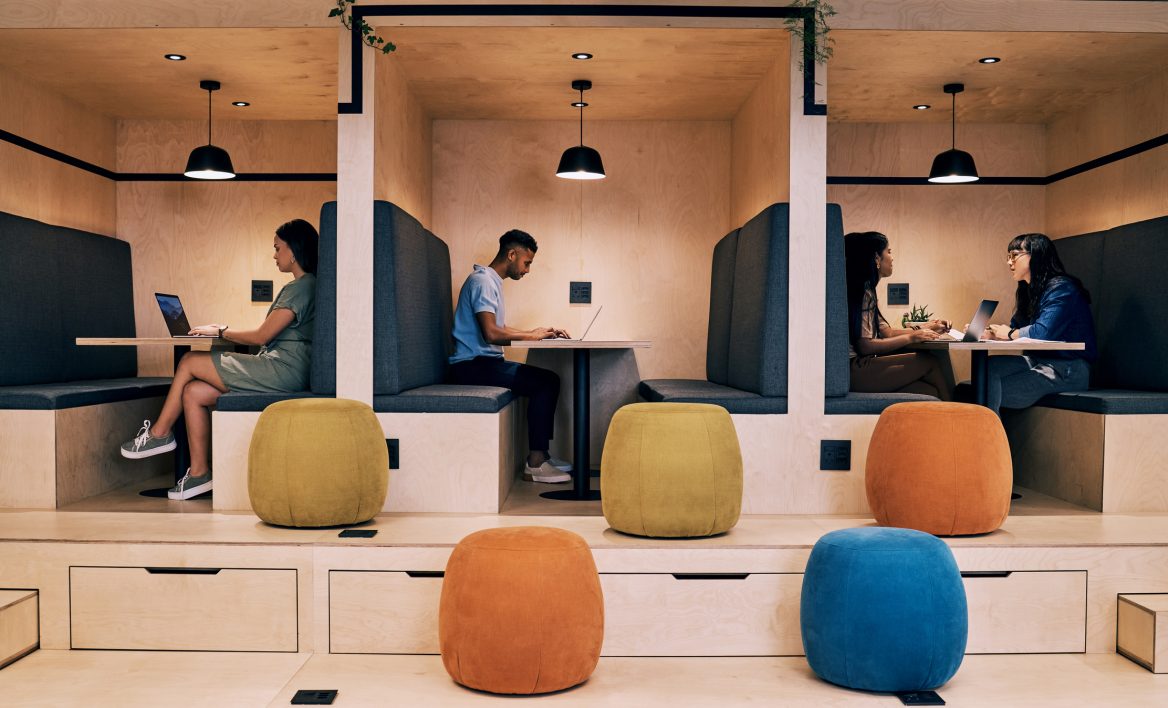The pandemic changed most aspects of daily life, especially in post-pandemic workplaces. Tenants want more from their commercial spaces now that health is the main priority for most workers. Property managers can read this guide to learn how to meet the needs of post-pandemic workplaces and retain long-term tenants who have a great rental experience.
Download Printable Article (PDF) >>>

1. UPGRADE INCLUDED CURRENT TECH
Many commercial rental spaces come with tech packages. Ensure that any Wi-Fi packages offer updated speeds for expanding businesses. Looking into fiber-optic internet is an excellent option for properties with hardwired ethernet connections, but it’s only available for 25% of Americans, so it may not be available. Property managers can offer expanded packages with faster download speeds for potential tenants with more than five to 10 employees. They’ll appreciate the ease of access and the improved internet speed compared to household connections.
2. SPACE OUT DESKS
The Centers for Disease Control and Prevention (CDC) still recommend keeping a distance of six feet or more to limit the spread of COVID-19. Tenants will feel more comfortable with rental spaces that spread out desks
or have enough room to keep employees at that safe distance. Removing a conference room to make more floor space will make any property more appealing to business owners.
3. CREATE A HYBRID OFFICE FLOORPLAN
Hybrid workers are much more common than they were pre-pandemic. After experiencing remote life, people want their employers to keep that type of work as a long-term option. Floorplans that don’t consider that will be less intriguing to potential tenants.
Property managers can consider downsizing and building an office tailored for hybrid schedules. Include more space for fewer desks and conference rooms equipped for virtual meetings. Working with a full-service
construction company will ensure that one team handles every job and minimizes costs to keep your project on track and within budget. You’ll quickly flip your properties into evolved post-pandemic workplaces.
4. OFFER SHORTER LEASE TERMS
COVID-19 will remain a public health concern, so business owners are preparing for potential future waves that cause layoffs or closures. Signing year-long or multi-year leases for commercial spaces is much riskier than before the pandemic.
Property managers could accommodate that risk by offering shorter leases. Suppose businesses lose employees or experience a drop in customers due to people quarantining at home. In that case, no one has to deal with the legal complications of missed rent payments or broken leases because their rent is still affordable.
5. LOWER YOUR RENT TO BECOME COMPETITIVE
Rent has become a complicated topic for commercial business owners. The pandemic causes rental rates to skyrocket for residential and commercial properties, which is more difficult for family-owned businesses to afford.
Buildings and properties with lower rent will instantly become more competitive. Business owners will prefer the more affordable payments and the long-term potential for their location. Given that commercial rent rose during 2021, every economic advantage tenants can get will help meet the needs of the evolved workplace post-pandemic.
6. IMPROVE SANITATION MEASURES
Employees and management teams have been working together to create healthier workplace environments since fewer people need to work from home. They can provide masks and hand sanitizers every week, but
those can only go so far in protecting everyone’s health.
Commercial properties designed with sanitation measures in mind or updated with new equipment will become more highly valued to current and future tenants. Property managers could install air purification systems in
every office suite and conference room to minimize the spread of viruses. New air ducts eliminate potential health concerns related to mold buildup. Installing improved filters in air ducts is another way to optimize them for post-pandemic workplace needs. Tenants could also review an option to sign up for discounted weekly cleaning services with sanitation businesses that partner with property management companies.
7. POINT OUT SATELLITE SPACES
Large cities used to be the best place to build a company headquarters location. Everyone lived in or near them, but that changed when the pandemic caused skyrocketing case numbers and deaths in urban areas. The
close contact with strangers in residential buildings and densely packed streets caused 17% of city dwellers to move to rural areas in 2020.
Commercial headquarters are less viable for businesses when their employees live farther away and prefer not to commute. Those business owners are now looking to pandemic-proof their real estate by investing in secondary office locations. Satellite offices create shorter commutes for rural employees and protect against future viruses.
When teams don’t meet in one office, they limit how many people become exposed to a virus after in-person meetings. Anyone working in the additional office space can continue coming to work because they weren’t all
in the same room.
Property managers may find greater success in renting additional properties when framing them as satellite spaces. Emphasizing the lack of viral exposure and the potential to keep or attract hybrid employees in rural
areas will meet multiple needs in post-pandemic workplaces.
8. EMPHASIZE PRODUCTIVITY FEATURES
Commercial buildings don’t always take productivity into account. Minor updates can make a big difference in attracting and retaining tenants. While discussing options with interested parties, property managers need to
emphasize any new features that aid productivity.
A recent study found that 47% of employees feel more tired when working under fluorescent light. Exhaustion creates a drop in productivity, so commercial tenants will benefit from rental spaces that improve productivity
through additional natural lighting. Mentioning newly installed or expanded windows is essential for impressing new tenants.
Other features like extra video conferencing rooms complete with updated tech will also make properties more appealing. Employees and management teams won’t have to worry about productivity slipping just because
everyone’s getting used to post-pandemic workplaces in addition to hybrid schedules influenced by the pandemic.
Meet the needs of post-pandemic workplaces
Business owners and employees look for different features when considering commercial real estate. Property managers can use these ideas to figure out how to meet the needs of the evolved workplace post-pandemic. Everyone involved will experience greater professional success while optimizing their time and budgets.
Rose Morrison is a residential and commercial real estate writer and the managing editor of Renovated. To see more of her work visit:: https://renovated.com/


